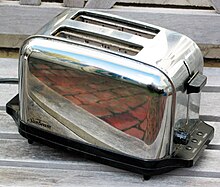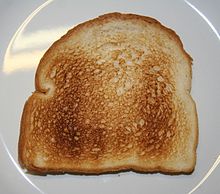Toast (food)
 A slice of bread, untoasted (left) and toasted (right) | |
| Type | Bread |
|---|---|
| Main ingredients | Sliced bread |
Toast is bread that has been browned by exposing to radiant heat. This browning is the result of a Maillard reaction, altering the flavor of the bread as well as making it firmer so it holds toppings more securely. Toasting is a common method of making stale bread more palatable.
Toasting methods

In a modern kitchen, the usual method of toasting bread is by the use of a toaster, an electrical appliance made for that purpose. To use a modern toaster, sliced bread is placed into the narrow slots on the top of the toaster, the toaster is tuned to the correct setting (some may have more elaborate settings than others) and a lever on the front is pushed down. The toast is ready when the lever pops up along with the toast. If the bread is insufficiently toasted, the lever can be pressed down again.
It can also be toasted by a new modern toaster witch are often used in hotels and meetings. Theas work by having one heating element on the top and one on the bottom and in between having a metal convener belt witch will carry the toast slowly through the two heating elements and therefor by the time it comes out the other side it is toast and not bread
Bread can also be toasted under a grill (or broiler), in an open oven, or lying on an oven rack. Toaster ovens are special small appliances made for toasting bread or for heating small amounts of other foods.
Bread can also be toasted by holding it near but not directly over an open flame, such as a campfire or fireplace; special toasting utensils (e.g. toasting forks) are made for this purpose. Before the invention of modern cooking appliances such as toasters and grills, this was the only available method of producing toast.
Toast is made using slices of bread. Many brands of ready sliced bread are available, some specifically marketing their suitability for toasting.
Consumption

Toast is most commonly eaten with butter or margarine spread over it, and may be served with preserves, spreads, or other toppings in addition to or instead of butter. Toast with jam or marmalade is popular. A few other condiments that can be enjoyed with toast are chocolate spread, cream cheese, and peanut butter. Yeast extracts such as Marmite in the UK, New Zealand and South Africa, and Vegemite in Australia are national traditions. Some sandwiches call for toast to be used rather than bread. The BLT is a prime example of this.
Toast is an important component of many breakfasts, and is also important in some traditional bland specialty diets for people with gastrointestinal problems such as diarrhea.
In the United Kingdom, a dish popular with children is a soft-boiled egg eaten with toast soldiers at breakfast. Strips of toast (the soldiers) are dipped into the runny yolk of a boiled egg through a hole made in the top of the eggshell, and eaten.[1]
In southern Sri Lanka it is common for toast to be paired with a curry soup and mint tea.
By 2013 "artisanal toast" had become a significant food trend in upscale American cities like San Francisco, where some commentators decried the increasing number of restaurants and bakeries selling freshly made toast at what was perceived to be an unreasonably high price.[2][3]
Health concerns
Toasted bread slices may contain high levels of acrylamide, a carcinogen generated during the browning process.[4] High acrylamide levels can also be found in other heated carbohydrate-rich foods.[5] The darker the surface colour of the toast, the higher its concentration of acrylamide.[4] That is why according to the recommendations made by the British Food Standards Agency, bread should be toasted to the lightest colour acceptable.[6]
Cultural references
Streetband released the novelty song Toast in 1978.[7] The band attempted to use toast as an instrument, with the sound of toast being scraped used later in the track.[citation needed]
Buttered toast has a perceived tendency, when dropped, to land with the buttered side to the floor, this being the least desirable outcome. Although originally a pessimistic joke, a 2001 study of the buttered toast phenomenon found that when dropped from a table, a buttered slice of toast landed butter-side down at least 62% of the time.[8] The phenomenon is widely believed to be due to the combination of the size of the toast and the height of the typical dining table, which means that the toast will not rotate far enough to right itself before encountering the floor.[9] A joke that plays on this tendency is the buttered cat paradox; if cats always land on their feet and buttered toast always lands buttered side down, it questions what happens when buttered toast is attached to a cat's back.
Other foods which are toasted
Cheese[10] and marshmallows are also toasted by exposure to dry radiant heat.[11]
See also
- Bruschetta
- Crostini
- Croutons
- French toast
- Fried bread
- Kaya toast
- Melba toast
- Milk toast
- Panino
- Texas toast
- Toast rack
- Toast sandwich
References
- ^ "Egg with Toast Soldiers". Retrieved 2010-08-06.
- ^ J. O'Dell, "$4 toast: Why the tech industry is ruining San Francisco", VentureBeat, August 21, 2013.
- ^ John Gravois, "A Toast Story: How did toast become the latest artisanal food craze? Ask a trivial question, get a profound, heartbreaking answer." Pacific Standard, January 13, 2014.
- ^ a b Jackson LS; Al-Taher F (2005). "Effects of consumer food preparation on acrylamide formation". Adv. Exp. Med. Biol. 561: 447–465. doi:10.1007/0-387-24980-X_34. PMID 16438318.
{{cite journal}}: Invalid|display-authors=2(help) - ^ Tareke E; Rydberg P.; et al. (2002). "Analysis of acrylamide, a carcinogen formed in heated foodstuffs". J. Agric. Food. Chem. 50 (17): 4998–5006. doi:10.1021/jf020302f. PMID 12166997.
- ^ "Acrylamide". food.gov.uk. Food Standards Agency. Retrieved 25 February 2014.
- ^ Streetband on the Official Charts Company website, retrieved 26 May 2012
- ^ "Breakfast at Murphy's (or why the toast lands butter-side down)". The Telegraph. 27 May 2001. Retrieved 19 December 2012.
- ^ http://www.maa.org/devlin/devlin_july_98.html
- ^ [1]Freeman, Bobby "First Catch Your Peacock," Y Lolfa Cyf, 1996,page 154. ISBN 0 86243 315 0
- ^ [2]Brocket, Jane, "Turkish delight & treasure hunts: Delightful treats and games from classic children's books," Penguin Group, 2009, no page number, eISBN 978-1-101-44325-5.

